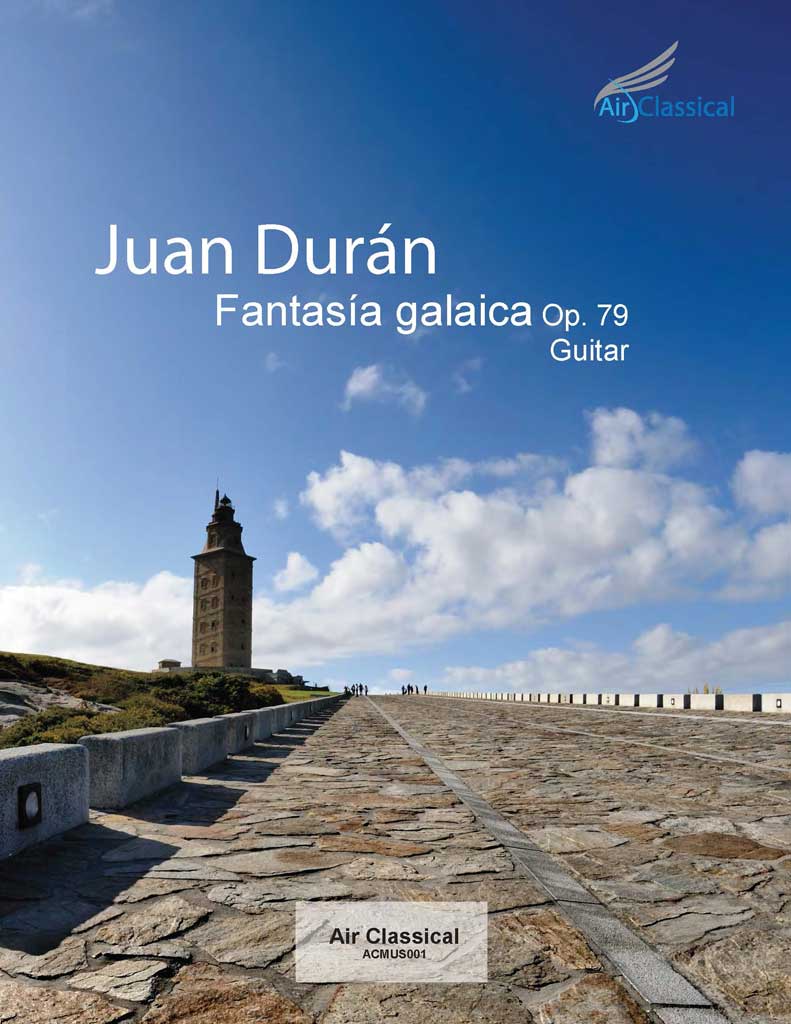Juan Durán / Fantasía galaica Op. 79
| Notes (EN) | Notas (ES) | Video | Credits |
NOTES on Fantasía Galaica Op. 79 - Guitar
With unequivocal brevity, the Fantasía Galaica Op. 79 is a compact musical suite that incorporates motifs drawn from Galician popular folklore taken from famous popular song books, such as Casto Sampedro's or Bal y Gay's. A derivative formula of these folkloric themes serves the composer both to develop and vary pre-existing motifs and to provide this instrument with a traditional, definitive work of Galician roots. Fantasía Galaica includes six dances that are performed successively, without interruption.
The suite opens with the introductory Alborada, followed by a Muiñeira, a dance that shares a moderate 6/8 tempo similar to the Catalan Sardana. The third piece is a lullaby with a characteristic, intimate binary rhythm that evokes an atmosphere of serenity.
As with the Siete Canciones Populares Españolas by Manuel de Falla, the author combines the dances to create the effect of contrast and variety. The fourth dance, as in Falla's aforementioned work, is a Foliada, which is similar to a Galician Jota. Like in other type of Spanish jotas (Aragonese, Castilian, etc.) it is a lively piece, which conveys a dancer's leaps.
The two final pieces are more firmly rooted in the most ancient culture of the Galician country. The Alalá is a type of melody of uncertain origin (some people situate it in the East), which is both evocative and pure in its simplicity. One of its features is the how the musical phrases close with an echo reminiscent of Gregorian chants. And finally: a Pandeirada, fast dance, akin to the Muiñeira, with a ternary rhythm that alludes to one of the most significant instruments in Galicia, the pandeiro, a square double-face frame drum.
The work was composed in the summer of 2008 with specific care given to replicating elements of traditional Galician instruments upon the guitar. For example, the musical articulation of Galician bagpipes is emulated by rapid groups of slurs and Galician percussion is imitated via fretboard tapping with the left hand whilst strumming two strings with a single finger of the right hand.
The Fantasía Galaica made its premiere on July 27, 2008, at the Goethe Institute in Bangkok during the Guitar Festival in Thailand by guitarist José Manuel Dapena, to whom the work is dedicated.
NOTAS Fantasía Galaica Op. 79 - Guitarra
Dentro de una cierta brevedad, la Fantasía está constituida como una breve Suite que incorpora motivos extraídos del folklore popular gallego, tomados de algunos célebres cancioneros como el de Casto Sampedro o el de Bal y Gay. Una fórmula que sirve al compositor, tanto para desarrollar y variar temas preexistentes, como para dotar a este instrumento de una obra identitaria de las raíces gallegas de corte tradicional. La Fantasía Galaica contiene seis danzas que se interpretan sin solución de continuidad.
Se inicia con una Alborada, pieza noble de carácter introductorio, seguida de una Muiñeira, danza que, al igual que la Sardana catalana, se acompasa moderadamente sobre un 6/8. La tercera pieza es un canto de cuna con su característico e íntimo ritmo binario en un ambiente de placidez sonora.
Al igual que en las Siete Canciones Populares Españolas de Manuel de Falla, el autor combina las danzas a la búsqueda del contraste y la variedad. La cuarta danza, como en la citada obra de Falla, es una Foliada, que equivale a decir Jota gallega. Como en otro tipo de jotas españolas (aragonesa, castellana, etc.) es una danza vigorosa que propende al salto.
Las dos piezas finales están firmemente enraizadas en la más ancestral cultura del país gallego. El Alalá es un tipo de melodía de origen incierto (hay quien la sitúa en Oriente), tan evocadora como pura en su sencillez. Una de sus características es la desinencia de las frases que remite a la línea del canto gregoriano. Y para terminar: una Pandeirada. Danza rápida, muy emparentada con la Muiñeira, de ritmo ternario y que sugiere la danza sobre instrumentos de percusión, alusión a uno de los instrumentos más significativos de Galicia: el pandeiro.
La obra fue compuesta en el verano del 2008 con un tratamiento muy guitarrístico, cuidando las articulaciones de la gaita gallega, con golpes de la mano izquierda, rasgueados y dobles cuerdas con un solo dedo de la mano derecha para imitar la percusión gallega.
La Fantasía Galaica fue estrenada el 27 de Julio de 2008 en el Instituto Goethe de Bangkok durante el Festival de Guitarra de Tailandia por el guitarrista José Manuel Dapena a quien está dedicada la obra.
http://www.youtube.com/watch?v=NAU7p6fjW9o
Juan Durán (1960 - )
Fantasía galaica Op. 79
Alborada
Muiñeira
Canto de berce
Foliada
Alalá
Pandeirada
Cover photography by Luxian
Notes by Juan Durán
Translated by Julia Crowe
Depósito legal: C 1692-2012, Biblioteca Nacional de España, bne.es
ISMN: 9790901319806
SKU: ACMUS001
Time: 6´
World premiere by José Manuel Dapena - Bangkok Guitar Festival 2008
http://www.youtube.com/josemanueldapena
© 2008 by Juan Durán - www.musicjuanduran.com
This edition: © 2012 Air Classical - www.airclassical.com



